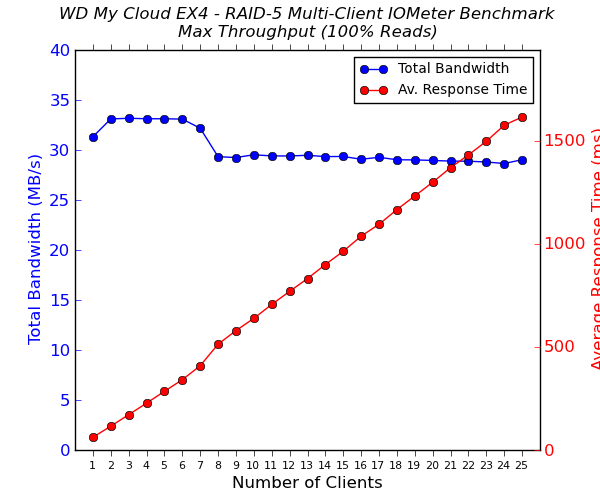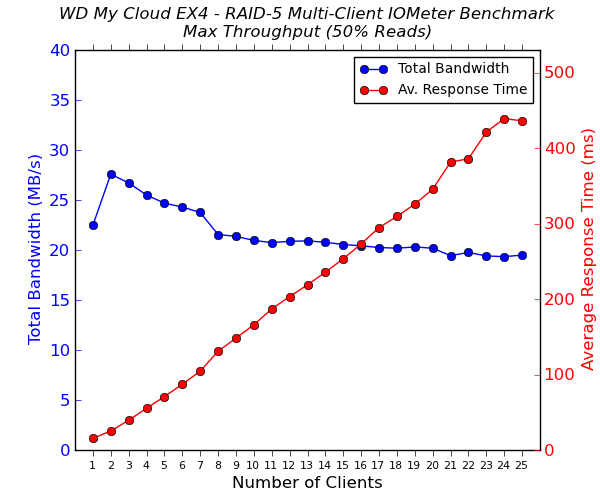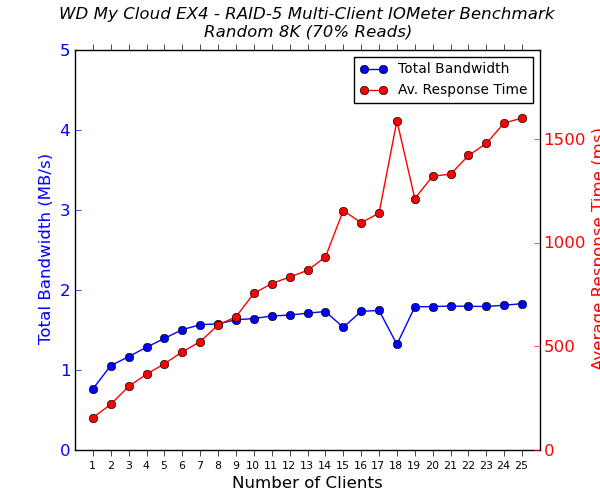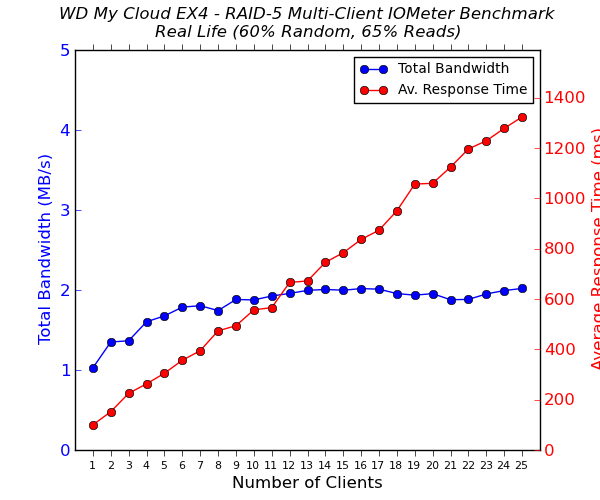Western Digital My Cloud EX4 and LenovoEMC ix4-300d Home NAS Units Review
by Ganesh T S on February 26, 2014 2:30 AM EST- Posted in
- NAS
- Western Digital
- LenovoEMC
Multi-Client Performance - CIFS
We put the LenovoEMC ix4-300d and WD EX4 through some IOMeter tests with a CIFS share being accessed from up to 25 VMs simultaneously. The following four graphs show the total available bandwidth and the average response time while being subject to different types of workloads through IOMeter. IOMeter also reports various other metrics of interest such as maximum response time, read and write IOPS, separate read and write bandwidth figures etc. Other interesting aspects from our IOMeter benchmarking run can be found here for the ix4-300d and here for the EX4.




Note that the scales on the graphs are different for the EX4 and the ix4-300d. While the ix4-300d is more than able to saturate a single GbE link, the WD EX4 struggles. In fact, the only saving grace is that the degradation in performance is not much as the number of clients go up, but, then, the initial performance itself was not very impressive. However, for home users who are the target market for the EX4, this may not be a very big concern. The other odd result was that the ix4-300d tended to choke on the rapid 50% sequential read / 50% sequential write test as the number of clients increased. Note that these benchmarks were done with firmware version 3.3.4.29856. Since then, LenovoEMC has released a number of firmware updates with various improvements which might have possibly fixed the issue. In any case, for 5 to 10 simultaneous clients, the performance of the ix4-300d far exceeds that of the EX4.










38 Comments
View All Comments
Sorwis - Monday, March 3, 2014 - link
Torrent clients are included in many NAS/home servers. I think every single Buffalo model has it and it's wonderful. Nothing wrong with torrents even though they are widely used to obtain copyrighted material.Zepid - Sunday, March 9, 2014 - link
The 10 ten downloaded torrents last year were all legal, fyi.hoboville - Wednesday, February 26, 2014 - link
Using SSH on the Lenovo unit voids the warranty? Of all the...nubian1 - Wednesday, February 26, 2014 - link
I find reviews of NAS appliances very interesting. For the most part the majority of the available "Consumer Level" devices solidify my opinion that it's is better to build your own then to purchase a prepackaged device. Naturally this depends on the users tech level but honestly it isn't all that hard. Both on a performance and financial level, rolling your own more often than not will lead to better results. Rolling your own hardware combined with a great piece of software like FreeNAS, which btw is very extensible with plugins if needed, and you are off to the races at a cash outlay that will often be less than competing prepackaged devices and if the hardware is chosen correctly, better performance.demonbug - Wednesday, February 26, 2014 - link
18-20 watts at idle seems pretty high for what looks like pretty low-powered solutions; that's only a few watts less than the 6-bay Xeon-based NAS from Netgear you reviewed a while back. Considering that in a home environment it is going to be spending 99% of the time idle, it seems like keeping the idle power use down would be very important. That said, I'm not too familiar with NAS products - do they keep the disks spinning at idle?ganeshts - Wednesday, February 26, 2014 - link
The reported idle power is with 4 hard drives not fully spun down inside the NAS. The RN716 was idling with SSDs :)demonbug - Wednesday, February 26, 2014 - link
Ah, makes sense. Thanks for the reply.jardows2 - Wednesday, February 26, 2014 - link
This review makes me want to go price out building my own NAS. I do have a question though; What is the benefit of multiple NICs for a home NAS server? Link aggregation requires a special switch, and I cannot think that in a home/soho environment, network segregation would be needed. Failover redundancy could be a benefit, but I can't think of anything else.ganeshts - Wednesday, February 26, 2014 - link
Link-aggregation enabled switches can be had for less than $100 [ like this one : http://www.amazon.com/Netgear-GS108T-NAS-Prosafe-8... ]Multiple NICs can be useful if you are running a server backing up data from multiple machines in the household (I know of many who backup the PCs in their household everyday at 3 AM -- so that is all simultaneous traffic).
MTN Ranger - Wednesday, February 26, 2014 - link
How do these two NASs compare to a popular and similarly priced model like the Synology DS413j? For that matter, how about a review of the DS413j?